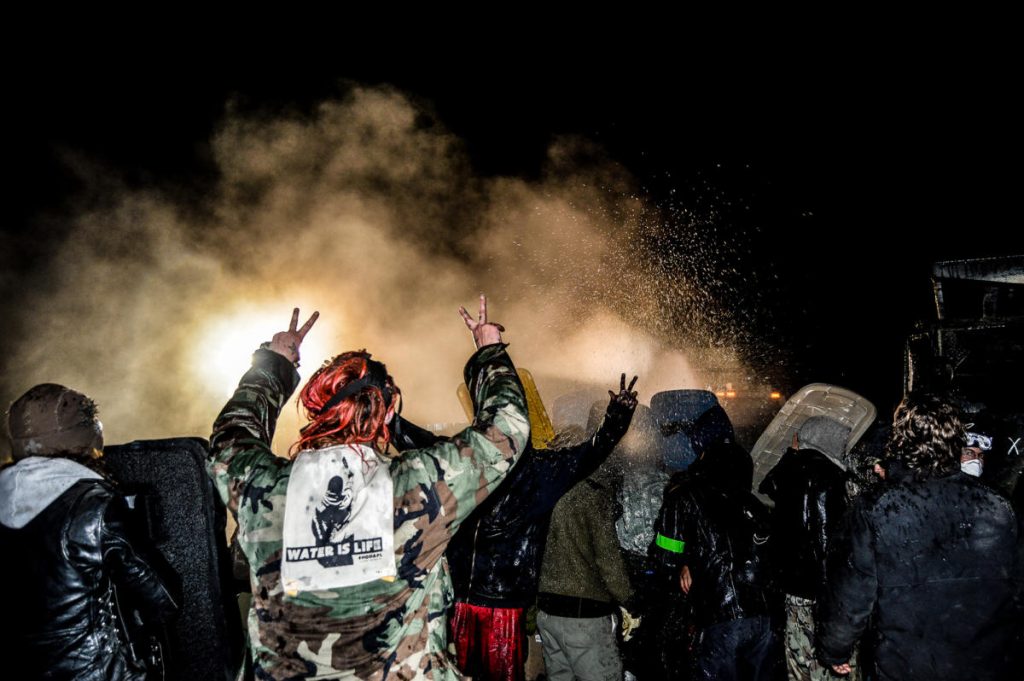by The New Yorker

“Imagine if Energy Transfer Partners planned to drill underneath Jerusalem.”
The snow-scoured hills and buttes of the Missouri Breaks are dotted with isolated houses, until the sudden appearance of the Oceti Sakowin encampment on the Standing Rock Sioux Reservation. The presence of so many people catches at the heart. Snow-dusted tepees, neon pup tents, dark-olive military tents, brightly painted metal campers, and round solid yurts shelter hundreds on the floodplain where the Cannonball River meets the Missouri. Flags of Native Nations whip in the cutting wind, each speaking of solidarity with the Standing Rock tribe’s opposition to the Dakota Access Pipeline, or D.A.P.L., owned by Energy Transfer Partners and Sunoco Logistics. This pipeline would pass beneath the Missouri River and imperil drinking water not only for the tribe but for farmers, ranchers, and townspeople all along the river’s course.
Oceti Sakowin, or Seven Fires, refers to the seven divisions of the Lakota, Dakota, and Nakota, people who are perhaps best known for their resistance to colonization (Little Big Horn, 1876), their suffering (Wounded Knee, 1890), and their activism (Wounded Knee, 1973). One of their most famous leaders, Sitting Bull, was murdered in the town that is now their tribal headquarters, Fort Yates. Down the road from Fort Yates is the town of Cannonball, named for the large round stones polished by the whirlpool that marked the convergence of the two rivers, just outside the Oceti Sakowin camp. The round stones disappeared when the Army Corps of Engineers dammed the Missouri, in a giant project that lasted from 1948 to 1962. The result of that project, Lake Oahe, flooded Standing Rock’s most life-giving land. The Lakota were forced onto the harshly exposed grazing uplands, and they haven’t forgotten that, or much else. History is a living force in the Lakota way of life. Each of the great events in their common destiny includes the direct experience of ancestors, whose names live on in their descendants. It is impossible to speak of what is now happening at Standing Rock without taking into account the history, as well as the intense spirituality, that underlies Seven Fires resistance.
On December 3rd, veterans from all over the country began to arrive at Standing Rock. Jack Dalrymple, the governor of North Dakota, and the Army Corps of Engineers had called for the camp to be cleared of protesters, who from the beginning have preferred the term “water protectors,” on the 5th. Vehicles were lined up for nearly a mile to get into the camp. It did not seem possible that many more people could fit onto the space, but somehow the camp seemed to morph to hold envoys from all over the globe. To name a few: Maori, Muslims, delegations of priests and ministers, people from more than ninety Native Nations, plus any number of Europeans, and various rock stars. The curious came, the bold, the devoted, not to mention the Water Wookie Warriors, whose pop-up camper had a “Star Wars” theme; passionate young Native people as well as seasoned elders joined the resistance camp. The arrival of veterans adept at winter survival and ready to join the fight against the pipeline was yet another influx.
A small group of veterans in various patterns of camouflage gathered before their first briefing, standing in the sun outside the tiny plywood and thermal-sheathed headquarters at the eastern edge of Oceti Sakowin. There had been rumors that supply stores in the area were not serving anti-D.A.P.L. customers, and that police were blocking or fining anyone who attempted to bring building supplies to Standing Rock. But, a few feet away, supplies were being unloaded and a barracks was quickly taking shape. A tall, rugged National Guardsman wearing a wool stocking hat and a tactical desert scarf talked to me before the briefing began.
“I have been on the front lines of other protests, but I’m here because of the brutality of this police response,” he said. “They thought they were way out here and could do anything.”
 Stand With Standing Rock
Stand With Standing Rock